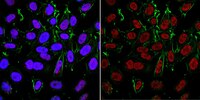MABE1068 Sigma-AldrichAnti-APE/Ref-1 Antibody, clone 13B8E5C2
Anti-APE/Ref-1, clone 13B8E5C2, Cat. No. MABE1068, is a highly specific mouse monoclonal antibody, that targets APE1 and has been tested in Immunocytochemistry, Immunohistochemistry (Paraffin), and Western Blotting.
More>> Anti-APE/Ref-1, clone 13B8E5C2, Cat. No. MABE1068, is a highly specific mouse monoclonal antibody, that targets APE1 and has been tested in Immunocytochemistry, Immunohistochemistry (Paraffin), and Western Blotting. Less<<Produits recommandés
Aperçu
| Replacement Information |
|---|
Tableau de caractéristiques principal
| Species Reactivity | Key Applications | Host | Format | Antibody Type |
|---|---|---|---|---|
| M, H, R | ICC, WB, IH(P) | M | Purified | Monoclonal Antibody |
| References |
|---|
| Product Information | |
|---|---|
| Format | Purified |
| Presentation | Purified mouse IgG2a in buffer containing 0.1 M Tris-Glycine (pH 7.4), 150 mM NaCl with 0.05% sodium azide. |
| Quality Level | MQ100 |
| Physicochemical Information |
|---|
| Dimensions |
|---|
| Materials Information |
|---|
| Toxicological Information |
|---|
| Safety Information according to GHS |
|---|
| Safety Information |
|---|
| Storage and Shipping Information | |
|---|---|
| Storage Conditions | Stable for 1 year at 2-8°C from date of receipt. |
| Packaging Information | |
|---|---|
| Material Size | 100 μg |
| Transport Information |
|---|
| Supplemental Information |
|---|
| Specifications |
|---|
| Global Trade Item Number | |
|---|---|
| Référence | GTIN |
| MABE1068 | 04054839090264 |
Documentation
Anti-APE/Ref-1 Antibody, clone 13B8E5C2 FDS
| Titre |
|---|
Anti-APE/Ref-1 Antibody, clone 13B8E5C2 Certificats d'analyse
| Titre | Numéro de lot |
|---|---|
| Anti-APE/Ref-1, clone 13B8E5C2 -Q2774444 | Q2774444 |










